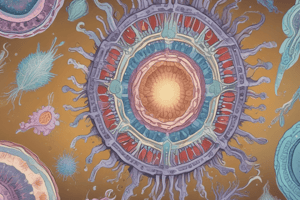Podcast
Questions and Answers
Protozoa are (circle the correct answer):
Protozoa are (circle the correct answer):
- single-celled organisms (correct)
- multicellular organisms
Protozoa belong to the group (circle the correct answer):
Protozoa belong to the group (circle the correct answer):
- prokaryotes
- none of these groups
- metakaryotes
- eukaryotes (correct)
The main routes of transmission of protozoal infections are (circle the correct answers):
The main routes of transmission of protozoal infections are (circle the correct answers):
- transmission by arthropods (correct)
- droplet transmission
- ingestion of infective stages (correct)
- contact
Protozoa are divided into two groups: protozoa of the digestive and __________ tract
Protozoa are divided into two groups: protozoa of the digestive and __________ tract
The class Rhizopodea includes (circle the correct answer):
The class Rhizopodea includes (circle the correct answer):
The class Rhizopodea comprises (circle the correct answers):
The class Rhizopodea comprises (circle the correct answers):
Entamoeba dysenteriae parasitizes in (circle the correct answer):
Entamoeba dysenteriae parasitizes in (circle the correct answer):
Entamoeba dysenteriae appears in the form of (circle the correct answers):
Entamoeba dysenteriae appears in the form of (circle the correct answers):
Entamoeba dysenteriae is transmitted by (circle the correct answer):
Entamoeba dysenteriae is transmitted by (circle the correct answer):
The histolytica form of Entamoeba dysenteriae is (circle the correct answer):
The histolytica form of Entamoeba dysenteriae is (circle the correct answer):
The vector for Leishmania Donovani is:
The vector for Leishmania Donovani is:
Leishmania tropica is the causative agent of:
Leishmania tropica is the causative agent of:
Leishmania is cultured on:
Leishmania is cultured on:
The vector for Leishmania brasiliensis is:
The vector for Leishmania brasiliensis is:
Trypanosoma Gambiense Duton causes:
Trypanosoma Gambiense Duton causes:
The vector for Trypanosome Gambiense Duton is:
The vector for Trypanosome Gambiense Duton is:
The vector for Trypanosome Rhodesiense is:
The vector for Trypanosome Rhodesiense is:
The vector for Trypanosome Cruzi is:
The vector for Trypanosome Cruzi is:
Trichomoniasis is transmitted by:
Trichomoniasis is transmitted by:
Trichomonas vaginalis is cultured on:
Trichomonas vaginalis is cultured on:
Flashcards are hidden until you start studying
Study Notes
Protozoa
- Protozoa are single-celled organisms that belong to the group of eukaryotes.
- They are divided into two main groups: protozoa of the digestive and urogenital tract, and protozoa of blood and tissues.
Rhizopodea
- The class Rhizopodea includes amoebae and consists of Entamoeba dysenteriae, free-living amoeba, and Giardia lamblia.
- Entamoeba dysenteriae parasitizes in the human large intestine.
- The histolytica form of Entamoeba dysenteriae is the vegetative form and consists of a central granular zone of endoplasm and a peripheral clear homogeneous zone of ectoplasm.
- The minuta form of Entamoeba dysenteriae is the luminal form and has less differentiated ectoplasm compared to endoplasm.
Transmission of Entamoeba dysenteriae
- Entamoeba dysenteriae is transmitted through the fecal-oral route.
- The cyst form of Entamoeba dysenteriae is the infective stage.
Diagnosis of Entamoeba dysenteriae
- Diagnosis is made by examining multiple stool samples.
- The material used for diagnosis is stool, aspirates, and material obtained by biopsy.
- Stained preparations are used to detect the parasite.
Free-Living Amoeba
- Free-living amoeba resides in soil and freshwater.
- It is the causative agent of amoebic meningoencephalitis.
Balantidium coli
- Balantidium coli belongs to the class Ciliatea.
- It parasitizes in the human large intestine.
- The vegetative form of Balantidium coli is called a trophozoite.
- The cyst form of Balantidium coli is the infective stage.
Giardia lamblia
- Giardia lamblia belongs to the class Zoomastigophorea.
- It causes giardiasis.
- The vegetative form of Giardia lamblia parasitizes in the duodenum and initial parts of the jejunum.
- The cyst form of Giardia lamblia is the infective stage.
Parasitology
- Amebic dysentery is a disease caused by Entamoeba dysenteriae.
- The causative agent of amebic dysentery is Entamoeba dysenteriae.
- Entamoeba dysenteriae is a protozoan.
- Leishmania Donovani is the causative agent of visceral leishmaniasis.
- The vector for Leishmania Donovani is Phlebotomus.
Malaria
- Plasmodium vivax causes Tertian malaria.
- Plasmodium malariae causes Quartan malaria.
- Plasmodium falciparum causes Tropical malaria.
- Malaria is transmitted by mosquitoes of the genus Anopheles.
Toxoplasmosis
- Toxoplasma gondii is a protozoan.
- Diagnosis of toxoplasmosis is made by detecting parasites in the blood or using an ELISA test.
- Toxoplasma gondii has an affinity for embryonic cells.
Helminths
- Dicrocoelium lanceolatum is a small fluke that parasitizes in the liver and bile ducts.
- Fasciola hepatica is a large fluke that parasitizes in the liver and bile ducts.
- Schistosoma haematobium is a parasite of the abdominal vein.
- Schistosoma mansoni is a parasite of the abdominal vein.
- Schistosoma japonicum is a parasite of the portal vein system.
Tapeworms
- Diphyllobothrium latum is a fish tapeworm.
- Hymenolepis nana is a small tapeworm.
- Taenia solium is a pig tapeworm.
- Taenia saginata is a beef tapeworm.
- Taenia echinococcus is a dog tapeworm.
Roundworms
- Ascaris lumbricoides is a roundworm.
- Enterobius vermicularis is a pinworm.
Ectoparasites
- Sarcoptes scabiei hominis is the causative agent of scabies.
- Pediculus capitis is the head louse.
- Pediculus vestimenti is the body louse.
- Pediculus pubis is the pubic louse.
- Malassezia furfur causes pityriasis versicolor.
Studying That Suits You
Use AI to generate personalized quizzes and flashcards to suit your learning preferences.




